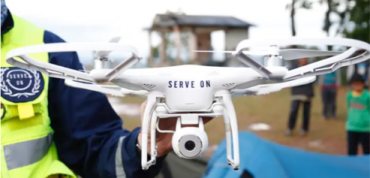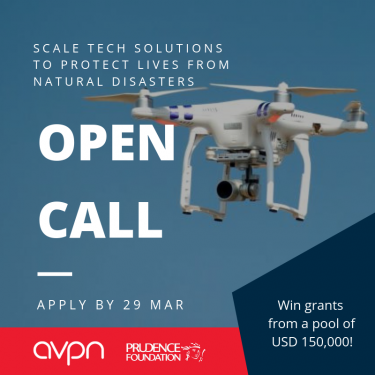
Harnessing the digital revolution to transform disaster preparedness and response
A person living in Asia-Pacific is 5-times more likely to be affected by a disaster than someone living outside the region. Between 2014 and 2018, disasters caused by natural hazards negatively impacted 650 million people in the region and resulted in a death toll of 35,000.
While governments across the region have made disaster management a priority, the increasing unpredictability, severity and complexity of disasters present ever growing challenges for humanitarian organizations and disaster management agencies. From common place devices like mobile phones to cutting edge solutions like big data analytics, technology holds the potential to increase the timeliness, reach, and impact of disaster preparedness and response efforts. Several creative technologies are already being deployed to advance disaster preparedness and response:
 Drones for real-time information, situation monitoring, and search and rescue: Drones offer the possibility of mapping terrain to assess damage in real time and can speed-up operations in hard to reach areas, such as the remote villages affected by the 2015 earthquake in Nepal. They can also help deliver medical supplies and identify survivors through infrared cameras and advanced listening systems.
Drones for real-time information, situation monitoring, and search and rescue: Drones offer the possibility of mapping terrain to assess damage in real time and can speed-up operations in hard to reach areas, such as the remote villages affected by the 2015 earthquake in Nepal. They can also help deliver medical supplies and identify survivors through infrared cameras and advanced listening systems.- Providing connectivity to expedite response time and coordination: Connectivity is essential in the aftermath of a disaster to facilitate information sharing and coordination between responders and with those that are affected. Cisco’s Tactical Operations provides the latest mobile networking technology free of charge to support the connectivity of relief agencies when communication networks are down. Companies like Vodafone are delivering similar solutions like the Instant Network Mini.
- Data analytics and crowdsourced maps to help prioritize response efforts: Over 7 million users checked in on Facebook’s Safety Check in the aftermath of Nepal’s 2015 earthquake. Such data points assist responders in making more effective decisions. One example is a partnership between the American Red Cross, International Federation of Red Cross and Red Crescent Societies and Facebook to develop Disaster Maps. Facebook data is aggregated to monitor where communities move to after a disaster. Such data – combined with other datasets – can improve the distribution of relief supplies.
- Blockchain to reduce risks and costs of distributing donations: Cash transfers – providing cash or vouchers as an alternative to in-kind assistance such as food – has become a common means for providing assistance in the aftermath of a disaster. Blockchain systems can eliminate the risk of losses caused by card theft and significantly reduce administrative costs by eliminating intermediaries. The transparency and security associated with blockchain also can support the accountability and transparency of digital transactions. After the 2015 Nepal earthquake, World Vision International piloted Sikka, a digital asset transfer platform, to distribute digital credits through SMS to beneficiaries that can be exchanged for cash or goods at participating locations.
 To harness technology for disaster preparedness and response, Prudence Foundation and AVPN, CSR Asia’s Strategic Partners, have launched the Disaster Tech Innovation Programme. The Disaster Tech Innovation Program is a competition for both for-profit and non-profit social purpose organizations that provide technology-based solutions to protect and save lives before, during, or after natural disasters. Finalists will stand a chance to receive grants from a pool of USD 150,000 to support the implementation and scaling of their technology and will be showcased at the AVPN Conference’s Deal Share Live event to enable further access to additional resources and collaborators. While interested applicants do not need to be registered in Asia-Pacific, their work should be relevant towards resolving a disaster-related issue in the Asia-Pacific region. The competition is now open for entries. Details of the application process, timeline and other relevant information can be found here. All are encouraged to share details of this competition with organizations interested in scaling their disaster tech solution.
To harness technology for disaster preparedness and response, Prudence Foundation and AVPN, CSR Asia’s Strategic Partners, have launched the Disaster Tech Innovation Programme. The Disaster Tech Innovation Program is a competition for both for-profit and non-profit social purpose organizations that provide technology-based solutions to protect and save lives before, during, or after natural disasters. Finalists will stand a chance to receive grants from a pool of USD 150,000 to support the implementation and scaling of their technology and will be showcased at the AVPN Conference’s Deal Share Live event to enable further access to additional resources and collaborators. While interested applicants do not need to be registered in Asia-Pacific, their work should be relevant towards resolving a disaster-related issue in the Asia-Pacific region. The competition is now open for entries. Details of the application process, timeline and other relevant information can be found here. All are encouraged to share details of this competition with organizations interested in scaling their disaster tech solution.
Building on the ongoing efforts of Prudence Foundation to promote disaster preparedness across Asia since 2013, the Disaster Tech Innovation Programme also seeks to encourage more organizations – innovators, like-minded funders, and resource providers – to contribute in this area. Those interested in finding out how to get involved, please contact Helen Roeth.
Programs such as Prudence Foundation’s Disaster Tech Programme fill a critical gap in the humanitarian sector where funding is generally only available after a disaster strikes. It is also an example of the evolving role of the private sector in addressing some the world’s most pressing challenges through innovation and new collaborations.